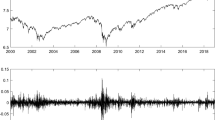Abstract
The threshold GARCH (TGARCH) models have been very useful for analyzing asymmetric volatilities arising from financial time series. Most research on TGARCH has been directed to the stationary case. This paper studies the estimation of non-stationary first order TGARCH models. Restricted normal mixture quasi-maximum likelihood estimation (NM-QMLE) for non-stationary TGARCH models is proposed in the sense that we estimate the other parameters with any fixed location parameter. We show that the proposed estimators (except location parameter) are consistent and asymptotically normal under mild regular conditions. The impact of relative leptokursis and skewness of the innovations’ distribution and quasi-likelihood distributions on the asymptotic efficiency has been discussed. Numerical results lend further support to our theoretical results. Finally, an illustrated real example is presented.
Similar content being viewed by others
References
Bai X, Russell J R, Tiao G C. Kurtosis of GARCH and stochastic volatility models with non-normal innovations. J Econometrics, 2003, 114: 349–360
Beran R. Minimum Hellinger distance estimates for parametric models. Ann Statist, 1977, 5: 445–463
Berkes I, Horváth L. The efficiency of the estimators of the parameters in GARCH processes. Ann Statist, 2004, 32: 633–655
Berkes I, Horváth L, Kokoszka P. GARCH processes: Structure and estimation. Bernoulli, 2003, 9: 201–227
Bollerslev T. Generalized autoregressive conditional heteroskedasticity. J Econometrics, 1986, 31: 307–327
Brown B M. Martingale central limit theorems. Ann Math Statist, 1971, 42: 59–66
Chan N H, Ng C T. Statistical inference for non-stationary GARCH(p, q) models. Electron J Statist, 2009, 3: 956–992
Engle R F. Autoregressive conditional heteroscedasticity with estimates of variance of U.K. inflation. Econometrica, 1982, 50: 987–1008
Engle R F, Rangel J G. The spline GARCH model for unconditional volatility and its global macroeconomic causes. NYU Stern School working paper, 2005
Fan J Q, Qi L, Xiu D C. Non-Gaussian quasi maximum likelihood estimation of GARCH models. http://faculty.chicagobooth.edu/dacheng.xiu/research/NGQMLE.pdf, 2013
Francq C, Zakoïan J M. Maximum likelihood estimation of pure GARCH and ARMA-GARCH processes. Bernoulli, 2004, 10: 605–637
Francq C, Zakoïan J M. Strict stationarity testing and estimation of explosive and stationary generalized autoregressive conditional heteroscedasticity models. Econometrica, 2012, 80: 821–861
Francq C, Zakoïan J M. Inference in non stationary asymmetric GARCH models. Ann Statist, 2013, 41: 70–98
Glosten L R, Jaganathan R, Runkle D. On the relation between the expected values and the volatility of the nominal excess return on stocks. J Finance, 1993, 48: 1779–1801
González-Rivera G, Drost F C. Efficiency comparisons of maximum-likelihood-based estimators in GARCH models. J Econometrics, 1999, 93: 93–111.
Hall P, Yao Q. Inference in ARCH and GARCH models with heavy-tailed errors. Econometrica, 2003, 71: 285–317
Hsieh D A. Testing nonliear dependence in daily foreign exchange rates. J Business, 1989, 62: 339–368
Hwang S Y, Baek J S, Park J A, et al. Explosive volatilities for threshold-GARCH processes generated by asymmetric innovations. Statist probab Lett, 2010, 80: 26–33
Jensen S T, Rahbek A. Asymptotic normality of the QMLE estimator of ARCH in the nonstatinary case. Econometrica, 2004, 72: 641–646
Jensen S T, Rahbek A. Asymptotic inference for nonstationary GARCH. Econometric Theory, 2004, 20: 1203–1226
Lee S W, Hansen B E. Asymptotic theory for the GARCH(1, 1) quasi-maximum likelihood estimator. Econometric Theory, 1994, 10: 29–52
Lee T W, Lee S. Normal mixture quasi-maximum likelihood estimator for GARCH models. Scand J Statist, 2009, 36: 157–170
Li C W, Li W K. On a double-threshold autoregressive heteroscedastic time series model. J Appl Econometrics, 1996, 11: 253–274
Linton O, Pan J Z, Wang H. Estimation for a non-stationary semi-strong GARCH(1,1) model with heavy-tailed errors. Econometric Theory, 2010, 26: 1–28
Loretan M, Phillips P C B. Testing the covariance stationarity of heavy-tailed time series. J Empir Finance, 1994, 1: 211–248
Lumsdaine R L. Consistency and asymptotic normality of the quasi-maximum likelihood estimator in IGARCH(1,1) and covariance stationary GARCH(1, 1) models. Econometrica, 1996, 64: 575–596
Mikosch T, Stărică C. Limit theory for the sample autocorrelations and extremes of a GARCH(1, 1) process. Ann Statist, 2000, 28: 1427–1451
Pan J Z, Wang H, Tong H. Estimation and tests for power-transformed and threshold GARCH models. J Econometrics, 2008, 142: 352–378
Stărică C, Herzel S, Nord T. Why Does the GARCH(1, 1) Model Fail to Provide Sensible Longer-Horizon Volatility Forecasts? Chalmers: Chalmers University of Technology, 2005
White H. Maximum likelihood estimation of misspecified models. Econometrica, 1982, 20: 1–25
Zhang Z, Li W K, Yuen K C. On a mixture GARCH time-series model. J Time Ser Anal, 2006, 27: 577–597
Author information
Authors and Affiliations
Corresponding author
Rights and permissions
About this article
Cite this article
Wang, H., Pan, J. Restricted normal mixture QMLE for non-stationary TGARCH(1, 1) models. Sci. China Math. 57, 1341–1360 (2014). https://doi.org/10.1007/s11425-014-4815-1
Received:
Accepted:
Published:
Issue Date:
DOI: https://doi.org/10.1007/s11425-014-4815-1




